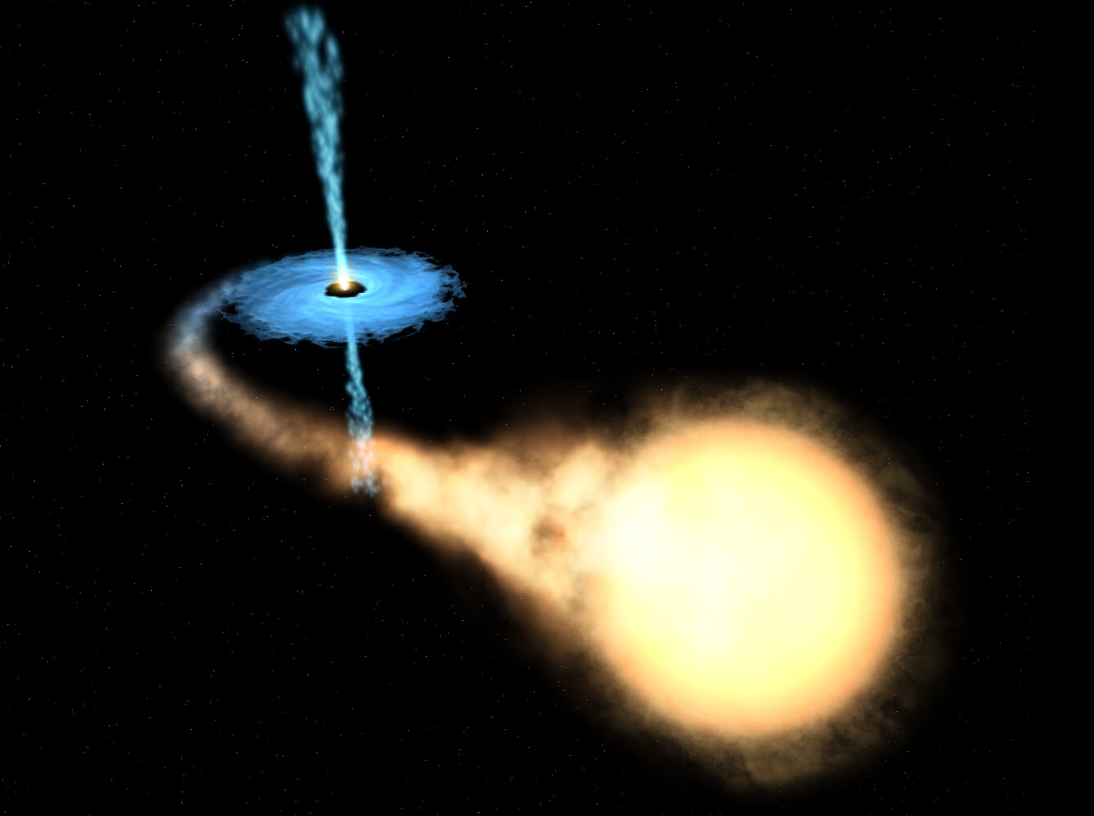
Phd Thesis
Duration
3 years
Tutor
Sara Motta
Contact
sara.motta AT inaf.it
Description
Accretion is a fundamental astrophysical process, which throughout the Universe leads to the generation of various types of outflows, including fast, collimated stream of matter called jets. Accretion jets occurs in a large variety of systems, from collapsed stars such as black holes (BHs) and neutron stars (NSs) in X-ray binaries (XRBs) to supermassive BHs in active galactic nuclei (AGN) and even in merging binary black holes or neutron stars that originate the gamma-ray bursts.
In X-ray binaries an accretion disc formed by matter stripped from a stellar companion is heated up to temperatures of millions of degrees and radiates in the X-ray band, while the associated accretion-fed jets emit synchrotron radiation, visible predominantly in the radio band.
In the theory of General Relativity (GR), the frequencies that characterize the motion of matter close to a rotating compact object (a neutron star or a black hole) can differ substantially from the classical frequencies in Newtonian gravity. GR predicts the existence of three different orbital frequencies: the relativistic Keplerian orbital frequency (in the azimuthal direction) and the related epicyclic frequencies: the vertical and radial epicyclic frequency (the so-called epicyclic frequencies).
GR predicts that the motion of matter in the immediate surroundings of black holes (BHs) carries the signature of yet untested strong-field gravity effects which are amongst the fundamental consequences of Einstein’s theory.
Quasi-periodic oscillations (QPOs) are commonly observed in the X-ray light curves of stellar-mass accreting compact objects. QPOs are the result of almost periodic fluctuations of the amount of light arising from an astronomical source and are detected and studied mainly through the analysis of a power density spectrum (PDS), produced via the Fourier analysis of the signal. QPOs are not coherent signals and in a PDS take the form of relatively narrow peaks with a characteristic centroid frequency measurable with high precision and a finite width. Different QPO types have been observed so far over a wide range of frequencies (from a tenth to several hundreds Hz) and in some cases multiple QPOs are seen simultaneously in the PDS of accreting sources. The relativistic-precession model (RPM) associates three types of QPOs observable in the PDS of accreting black hole binaries with a combination of the Keplerian frequency and the epicyclic frequencies. The nodal precession frequency or Lense-Thirring frequency (= Keplerian frequency – vertical epicyclic frequency) is associated with oscillations usually observed at low (0.1-20 Hz) frequencies, while the periastron precession (= Keplerian frequency – radial epicyclic frequency) and the Keplerian frequency are associated to two different types of high-frequency (30-450 Hz) QPOs, known as “lower” and “upper” high-frequency QPO (HFQPO) respectively. The analytical form of the keplerian, periastron precession, and nodal frequency only depend on three parameters: the mass and the spin of the black hole, and the radius at which the QPOs are generated. In 2014 the RPM was used to establish a successful method to self-consistently estimate the mass and the spin of a BH based only on the detection of QPOs.
Since high frequency QPOs are rare in black holes, the RPM has been so far used only to estimate the mass and spin of the black hole in three systems. Neutron stars, instead, commonly show the three types of QPOs that are relevant for the RPM, and hence they offer the unique opportunity to test this model on a large sample of systems. So far only two neuron star XRBs have been tested.
The aim of this thesis is to perform a detailed test of the RPM on a number of neutron star XRBs. These systems are more complex than their sisters black hole X-ray binaries, as they possess a solid surface and an anchored magnetic field. However, NS are more common than black holes in our and other Galaxies, and are thought to be potential sites of generation of continuous gravitational waves, which can be detected by the existing gravitational wave detectors (LIGO, VIRGO, KAGRA).
The Ph.D. candidate will test the RPM on a number of NS systems, starting from the Sco X-1, which is an important source for a number of reasons. Besides being relatively nearby and very bright, this is the primary target for the search of continuous gravitational waves. Hence, measuring the spin of the neutron star will have a high impact in field of the gravitational wave astronomy.
The candidate will analyze the QPOs observed in Sco X-1 and will attempt the first timing-based estimate of the spin of this source using the RPM. The same methodology will be applied to a number of NS XRBs using available and unpublished archival data (from the RXTE and HXMT satellites, and the NICER instrument). This will significantly increase the number of available spin and mass measurements for neutron star systems (from 2 to over 10). Then, after assessing the validity of the RPM for the study of neutron stars, the candidate will test a first version of the version of the model specifically developed to describe the complex space time near the surface of a neutron star on all the systems of the sample considered. This will result in a new, refined set of spin and masses, which will be interpreted in the context of the current understanding of neutron star X-ray binaries and their properties. Based on these finding, the candidate will contribute to develop further the model to best describe the data and to accurately extract crucial information about the structure of the neutron stars considered (i.e. the Equation of State), and will run the final tests on the final version of the model.
With this thesis we will obtain the first direct estimate of the quadrupole moment of a neutron star – a quantity that for now can only be measured during binary black holes or neutron star mergers producing gravitational waves – and we will provide a number of accurate spin values of galactic neutron star XRBs, which will be used by the gravitational waves community to constrain the search of continuous gravitational wave signals.
This work will deliver crucial insights into the properties of neutron stars, with the potential of triggering a massive step forward in the search of continuous gravitational waves form persistent sources. The results from this project will be relevant in a broad context, including the fundamental physics governing the properties and behaviour of matter in the presence of extreme gravitational fields.
The outcome of this thesis will be published in at least 3 peer-review publications in high-profile journals.
[Crediti immagine: ESA/HUBBLE]
